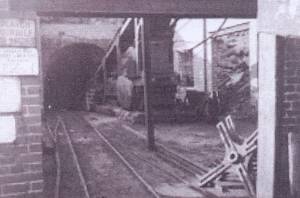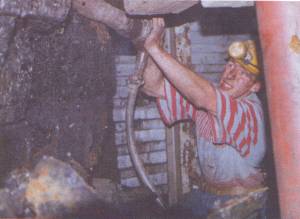|







     
|
Hill Top Colliery
Forest of Rossendale
Lancashire
|
|
Hill Top was opened out firstly in 1948, and was the only
colliery driven by the NCB in the Rossendale valley. It
was designed as one of those short life drift mines so popular
with the NCB at the time. Situated high on the moors on
the Yorkshire - Lancashire border, it was the second highest
in the western area, the highest being Deerplay Colliery,
to which it was later adjoined underground.
|
| Initial development works were later carried
out by men from the closed Moorfield Colliery, Accrington.
The manager, Bill Dewhurst, also came from that colliery.
Two drifts were driven approximately 500 yards down
to a large block of virgin coal in the Union mine (Lancashire
term for a seam) which averaged 4'6". The first
districts were driven towards the rise, and were mechanised
pillar and stalls, using a Dissington coal cutter, and
the Duckbill loaders. The headings were 12' wide. When
they had reached their extremity a slice was retreat
mined out towards the heading end. |
 Original hill top drift (NCB) early
1960s
Original hill top drift (NCB) early
1960s |
|
|
Conventional longwall faces were opened up using AB fifteen
cutters, (still used at Hay Royds and Monument), with all
the coal coming to the surface by conveyor. Union coal is
quite high in sulphur, and therefore a lot went to Widnes
for use in the chemical industry. In 1964, the first shearer
loaders were introduced into the pit and were successful,
except for the picks being blunted on the hard ironstone
nodules, which were common in the Union seam. About 200
men were employed in the colliery, mostly Bacup and Accrington
men, and it has been said by most of the men that it was
a good pit to work at.
|
 Billy Clayton riding in the main drift
of Grimebridge, 1980s
Billy Clayton riding in the main drift
of Grimebridge, 1980s |
By 1966, all available reserves had been worked and
sadly the colliery closed, leaving just two others
in Rossendale. The neighbouring Deerplay mine closed
two years later, whilst the last, Old Meadows, closed
in 1969.
This was by no means the end of the Rossendale mines,
as one miner from the NCB Grimebridge Colliery, which
closed around 1964, wondered what it would be like
to own his own mine, and after fourteen years of closure,
William (Billy) Clayton,
|
|
and his business partner, Rodney Mitchall started work on
Grimebridge Colliery in 1978. At first Billy Clayton worked
underground on his own, and Mitchall on the surface until
they could afford to hire men.
The new company, Clayton & Mitchall Ltd employed around
31 men in the early eighties, and expanded into Tan Lan Colliery
in Mold, North Wales. Things rapidly deteriorated, and by
1987 just Billy Clayton remained, and he was helped by a retired
coal board electrician, who worked for three years without
pay. The only good thing to come out of these awful times
was that the old proverb, "a friend in need" still
found a place at Grimebridge.
|
|
Despite an enforced, long closure in 1990 - 92, Grimebridge
kept working in one form or another., until the summer
of 1996, when, whilst employing six men, a lack of
remaining reserves and financial pressure caused the
mine's final closure.
After an absence of about a year, the Grimebridge
Colliery Co. Ltd obtained the Hill Top licence, and
in the summer of 1997, commenced to drive two drifts
into a large block of virgin coal left between the
old Hill Top workings and an opencast site that ran
across the outcrop on Heald Moor. As it was, the crop
edge of the old Deerplay Colliery was also being worked.
|
 Billy clayton's son at hill top coalface,
1997
Billy clayton's son at hill top coalface,
1997 |
|
|
The Present
The faces are currently working the Union seam, 4'6"
or thereabouts, and CAPs are used. Unfortunately, the coal
is exceptionally hard, a good collier will struggle to mine
six tonnes a day, and the price the company receives means
small profit margins.
The biggest problem for these small mines is the lack of
manpower, as nobody wants to work in them anymore. In truth,
Hill Top now has no workforce, save Billy Clayton, as all
the other men have had go in search of properly paid work.
The Future
Sadly, though reserves of over 150,000 tonnes remain, the
lack of manpower has forced the colliery to remain largely
inactive, last year's production being less than 50 tonnes.
However, experiments into forms of machinery are taking
place. Billy Clayton, despite being past retirement age,
is said to be very enthusiastic, and as long as he carries
on running the mine on his own, there should be a working
colliery in Lancashire.
|
Alex Potts©2004
All photographs on this page © Thomas
Imgrund
|
|


